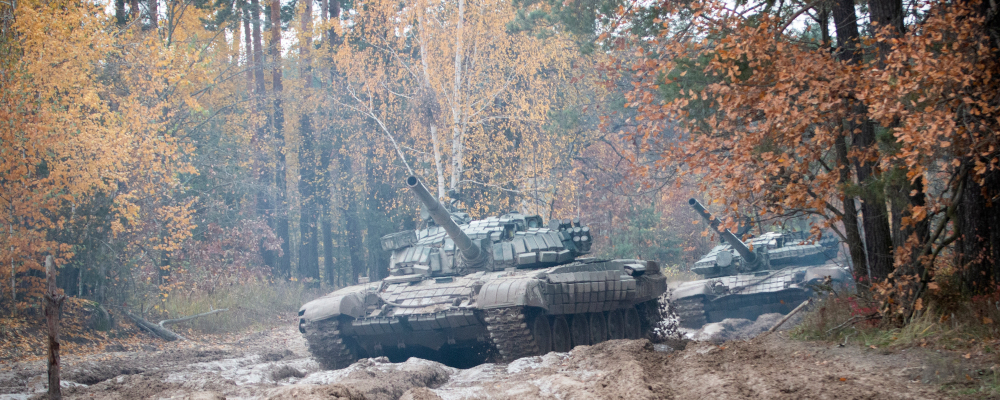Yesterday, the Government of Canada announced that it intended to send four Leopard 2 tanks to Ukraine as part of an allied effort to rush modern capabilities to the battlefield. The decision has been marked by significant debate over the past few weeks surrounding whether, and how many, tanks should be provided by Ottawa, their utility in modern warfare, and the state of the Canadian Armed Forces’ combat capability. These are all issues worth unpacking.
It is important to understand that Canada’s army is built around an expeditionary concept of operations. Canada has no real direct threat to its land territory. The force structure is built around deploying and sustaining a mechanized brigade group (about 5,000 troops) outside of Canada. This includes artillery, infantry, support, and armoured vehicles. This approach was designed to sustain foreign operations, as typified by operations in former Yugoslavia or Afghanistan.
While there was a short-lived plan to replace Canada’s tanks with the Stryker Mobile Gun System (essentially a wheeled Light Armoured Vehicle III with a 105mm gun mounted on top) in the early 2000s, it was quickly discovered that conventional tanks continued to have utility on the battlefield—they provided a unique direct-fire capability to accurately hit defended positions in the Kandahar valley and could also shrug off attacks that would damage or disable other platforms.
While there has been an extended commentary about the utility of tanks in modern warfare, they remain an integral part of any army’s force structure. They combine a synthesis of mobility, protection and firepower that can have decisive effects on a battlefield when used properly.
Canada’s armoured force design is also built around the expeditionary operations model, where the intent is that Canada could permanently deploy a squadron of around 20 tanks, which the total number of 82 then sustains. At any one time, a large number are undergoing routine maintenance or upgrades, which leaves only a few available for operations. There are also different versions of the tank in Canadian service, which roughly correspond to their intended role. First, Canada has 42 Leopard 2A4s that are largely used for training. These are the least capable version in Army service, and see the hardest usage of the entire fleet. Comments by the Chief of Defence Staff suggest that the four tanks that are to be sent to Ukraine come from this sub-fleet. The remaining 40 tanks are equally split between more heavily armoured 2A4M and 2A6M tanks. These two versions, which differ in the main gun they employ, are primarily used for foreign deployments as they are more capable than the standard 2A4. This arrangement worked relatively well in the past. However, there are two significant problems.
First, Canada’s armoured corps is currently in a relatively mediocre state. This is partly the result of manning levels and the geographic distribution of bases, which has detrimentally impacted the army’s ability to sustain a tank squadron. As such, it might not be able to deploy and sustain 20 tanks. This is a story that is extremely common across the CAF. The CF-18s and Halifax class-frigates are similarly highly constrained in their operations by the lack of personnel. In addition, the Leopard 2 fleet also requires an inordinate amount of time to maintain, and spare parts are hard to come by in Canada. Many European countries also have similar issues; the Royal Air Force’s Eurofighter Typhoon fighter, for instance, has been plagued by parts problems and high maintenance time. The current situation facing Canada’s Leopard tanks should be seen as a lesson for policymakers in Ottawa to get their respective house in order.
Second, while this force structure is lean and efficient under normal circumstances, Canada has little excess capacity to sustain losses or provide tanks to Ukraine without harming readiness. Four tanks are likely the most that the Canadian Army can provide immediately without harming its ability to train personnel. While providing more tanks to Ukraine further mires Russia’s forces in the conflict and supports Canada’s security interests, one cannot ignore the potential for direct escalation between Russia and NATO, regardless of the number of Leopards that are sent. The CAF already maintains an enhanced forward presence in Latvia, and a key contingency the army must plan for is to reinforce that unit. Canada’s tanks would be a key part of any force, particularly considering they are the army’s main system to defeat enemy tanks. The four tanks the CAF is donating come from the most numerous but least capable versions—their loss should not appreciably impact the future readiness of the armoured corps. However, the provision of additional vehicles may increasingly have consequences for the army.

Canada would also not be able to reliably replace such tanks. Leopard production has been relatively low, with the majority of work surrounding refurbishing old tanks into new models. Thus, donating any number will likely result in a permanent loss of combat power, at least for the foreseeable future.
Canada may not have a surplus of Leopards, but European countries do possess substantial reserves of the tank. During the Cold War, our European allies maintained a large standing and reserve forces in the event the conflict ever became hot. They maintained significant numbers of tanks in reserve storage, even as many of these states converted their militaries towards the expeditionary model by the 1990s. As such, many of them have dozens if not hundreds of Leopards that could be donated to Ukraine without the same pernicious effects on their force structure compared to Canada. Unofficial tallies about potential donations from countries like Spain and Finland illustrate this.
Instead of Leopards, a more prudent course of action would be for Ottawa to provide capabilities that it can sustain and reliably deliver for the length of the conflict. Canada has already provided 39 Armoured Combat Support Vehicles (ACSVs), built by General Dynamic Land Systems in London Ontario on the LAV6 Chassis. While certainly not as flashy as the Leopard 2 tank, vehicles such as these provide a valuable combat capability within a modern combat team. They are better than the Ukrainian Army’s current system in that role, the Soviet-era BTR-80. As a Canadian product, Ottawa can control a number of variables to maximize its effectiveness in Ukrainian service—this includes the provision of spare parts, complex repair work, and training.
However, obtaining additional ACSVs or similar types will require Ottawa to get creative. The 39 vehicles donated last summer were awaiting acceptance into the Canadian Army, but no more surplus vehicles currently exist. Some options include diverting existing Canadian or other allies’ orders to Ukraine or expanding production lines. While developing such an option requires significant negotiation and out-of-the-box thinking in Ottawa, it would be a valuable contribution to Ukraine’s ultimate peace and security.
Recommended for You

Alisha Rao: Canada must get its relationship with India back on track

Ginny Roth: The British Tories should follow Pierre Poilievre’s example—Win back the Right, then build from there

Richard Shimooka: Canada’s enemies aren’t just targeting elected officials—they’re trying to interfere with you too

‘It’s about preserving something larger than ourselves’: Five Takeaways from Ayaan Hirsi Ali’s conversation on pluralism, multiculturalism, and radical ideologies




